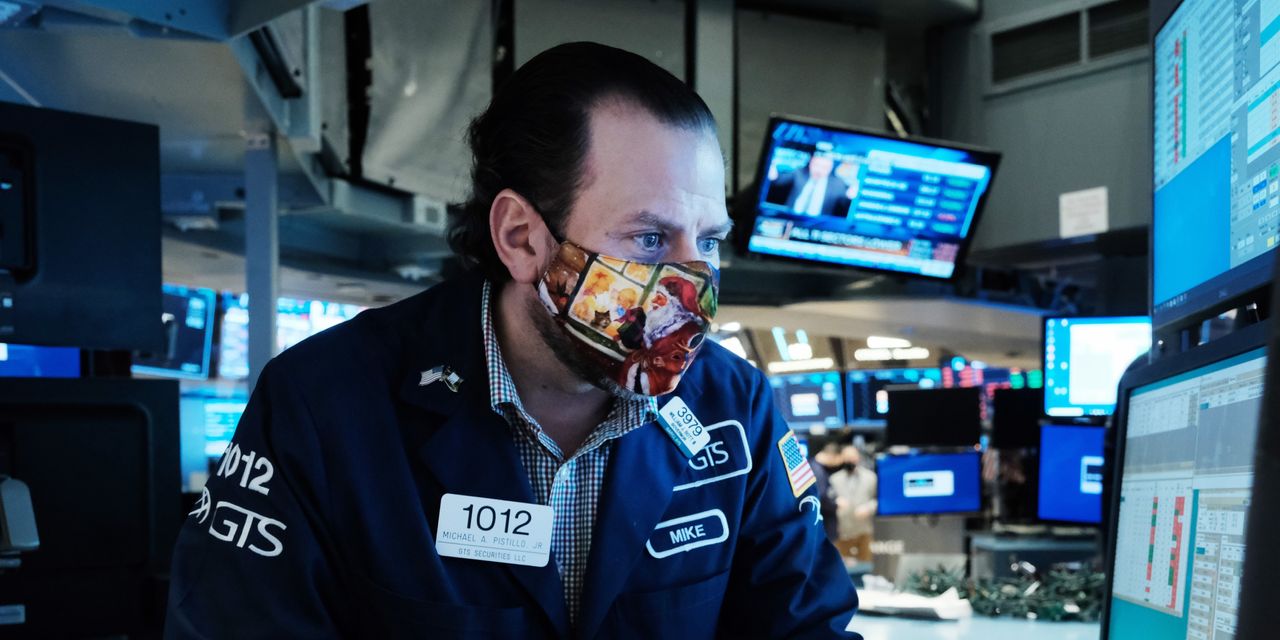U.S. stocks climbed Tuesday, resuming the seesaw action that has become markets’ signature since the emergence of the Omicron Covid-19 variant.
The S&P 500 advanced 81.21 points, or 1.8%, to 4649.23. The Nasdaq Composite rose 360.14 points, or 2.4%, to 15341.09. The Dow Jones Industrial Average gained 560.54 points, or 1.6%, to 35492.70. All three indexes fell in the three previous trading sessions, pushed down by worries over new Covid-19 lockdowns.
Investors have a mix of concerns heading into the end of the year. The rise in Omicron cases could prolong the global supply-chain disruptions that have added to inflation. However, there also are signs that vaccine boosters offer protection against Omicron. The Biden administration said Tuesday that it is preparing to distribute 500 million free at-home Covid-19 testing kits to Americans to tackle rising cases.
Meanwhile, some investors are hoping that a version of Democrats’ $2 trillion spending package can still be passed. Senate Majority Leader Chuck Schumer said Democrats would take up the legislation early next year, despite opposition from Sen. Joe Manchin.
Some traders were likely closing out positions before the end of the year, locking in gains. Omicron has whipsawed stocks since Thanksgiving, but the S&P 500 is still up more than 20% this year.
“The market is just rebounding after profit-taking in these last number of days because it’s been such a strong year,” said Linda Duessel, senior equity strategist at Federated Hermes. “We’re running out of time here but there is still a chance for that Santa Claus rally, which we’ve been cheering for.”
Investors said markets are having difficulty interpreting the long-term threat posed by the Omicron variant, signaling that some volatility could extend into next year.
“Everybody is trying to put decimal point accuracy on forecasts right now; that’s kind of a fool’s game,” said
Richard Bernstein,
chief executive at Richard Bernstein Advisors.
shares fell $2.73, or 4%, to $65.06 after the food company reported a quarterly profit that missed expectations.
shares gained $8.65, or 11%, to $90.68 after the memory-chip company posted strong results and provided better-than-expected forecasts.
shares climbed $2.65, or 21%, to $15.05 after the drugstore chain said that its plans to close stores will boost earnings.
shares rose $9.65, or 6.2%, to $166.63 after the sneaker maker posted earnings and sales that topped analysts’ expectations, despite persistent supply-chain challenges.

Some investors worry that a rise in Omicron cases could stall economic growth.
Photo:
Spencer Platt/Getty Images
Investors also are eyeing what themes are going to drive the markets next year. Value stocks, such as financials, energy, utilities, materials and industrials, tend to do well when interest rates go higher. However, investors will need to keep adjusting their outlook as the pandemic progresses.
“With the equity markets, it’s kind of like a biathlon,” said Larry Adam, chief investment officer at Raymond James. “We’ve been skiing very rapidly and then in the second part of the biathlon, you have target practice, where you have to be much more precise and focused with sector, individual stock and industry calls.”
The yield on the benchmark 10-year Treasury note ticked up to 1.487% Tuesday, its largest one-day gain in more than two weeks. Yields and prices move inversely.
Front-month Brent crude futures, the benchmark in global oil markets, rose $2.46, or 3.4%, to $73.98 a barrel, the largest one-day gain in about two weeks.
Overseas, the Stoxx Europe 600 rose 1.4%. Asian indexes closed with gains. Japan’s Nikkei 225 added 2.1% and China’s Shanghai Composite gained 0.9%. South Korea’s Kospi added 0.4%.
Write to Caitlin Ostroff at caitlin.ostroff@wsj.com
Copyright ©2021 Dow Jones & Company, Inc. All Rights Reserved. 87990cbe856818d5eddac44c7b1cdeb8
